Don't wanna be here? Send us removal request.
Text
Watford 2-1 Newcastle United – Tactical Review
Line-Ups
Javi Gracia partnered Troy Deeney with Andre Gray, with Roberto Pereyra returning on the left. Rafa Benítez rested the right flank of the team, with Matt Ritchie and Deandre Yedlin sitting out for Jacob Murphy and Javier Manquillo.
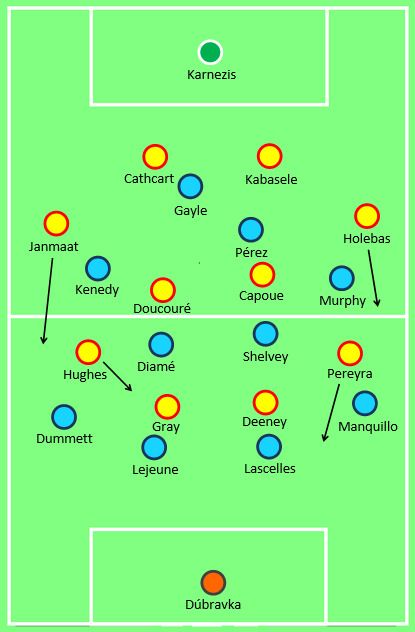
Watford Overwhelm Newcastle Defence
Both teams were roughly playing 4-4-2 – with Pérez playing his usual role just off Gayle – meaning that they were basically man-for-man across the pitch – every player had a direct opponent. Watford had 2 genuine strikers up front and their wide players were playing high and close to the forwards, meaning they were almost creating a 4v4 with Newcastle’s defence at times.
Watford started quickly and were ahead after just 2 minutes. The ball was played in towards Deeney; Lejeune tried to win it but Deeney used his body to shield the ball and allow it to run to Gray. Dummett cut out his pass but inadvertently played it to Doucouré, who calmly moved it on to Pereyra. With Manquillo having to cover round, Pereyra was now free to score at the back post.
With the 2 centre-backs each having a man to deal with, when one of the forwards went short, they weren’t sure whether to follow or not. On the opening goal, Lejeune went tight to Deeney but ended up on the floor and Diamé was also taken out of the game. This left a big space behind him, with Lascelles isolated 1v1.
Watford’s full-backs were also pushing on (particularly Janmaat) and Doucouré wasn’t afraid to make forward runs either. Hughes and Pereyra were drifting around and they were basically overwhelming Newcastle’s back 4. They were also leaving themselves open to a counter by committing so many men forward but Newcastle were struggling just to cope, so couldn’t take advantage.
Before the half hour mark, Watford made it 2-0. Pereyra, coming inside again, played a one-two and spun in behind Lascelles, down the inside-left channel. Gray stayed wide on the opposite side while Hughes made a run to the near post. Dummett got caught between the 2 as Pereyra (1v1 against Lejeune) cut back onto his right foot and crossed to Gray at the back post. Dúbravka tried to cut out the cross but missed, leaving an easy finish. Again, the movement of Watford’s front 4 was causing problems.
When the referee blew for half-time, Watford were frustrated that they weren’t even further ahead, after missing a penalty and a couple other good opportunities.
Switch To 3 At The Back
At half-time though, Benítez made a tactical change, as Newcastle switched to 3 at the back, with Dummett on the left of the 3 and Kenedy and Manquillo the wing-backs. Pérez and Murphy played behind Gayle, making it a 3-4-2-1. Essentially, this gave Newcastle a spare man against Watford’s front 2, meaning they could go tight, knowing there was someone to cover behind them. After struggling so much in the first half, they were able to gain a foothold in the game.
Whether by design or simply because Newcastle started coming into the game, Watford began to sit off more. Ritchie came on for Murphy, Newcastle began to gain more control and soon pulled a goal back, 10 minutes into the half.
Shelvey played the ball wide to Manquillo – the wing-backs began to get space behind Hughes and Pereyra – who was able to advance and whip an excellent cross in to the box. This time it was Newcastle who had a spare man over as Ritchie and Gayle occupied the 2 centre-backs, allowing Pérez to get free at the back post and he finished superbly.
Watford then replaced Pereyra and Deeney with Deulofeu and Mariappa, swapping a striker for a centre-back and switching to 5-4-1. Newcastle had nullified the front 2 to some extent and were now on top so Gracia made a change of his own. It was a somewhat negative move as Watford sat deeper, looking to protect their lead, but they perhaps wanted to exploit the space behind Newcastle’s wing-backs on the break with the pace of Gray and Deulofeu.
Yedlin then came on for Manquillo and Newcastle reverted back to (roughly) 4-4-2. There was now no need for the extra centre-back and they needed an equaliser. However, Yedlin continued to play like a wing-back and was a real threat down the right flank with his (and Ritchie’s) fresh legs.
As we’ve seen many times this season, Shelvey was looking to spread the ball out to the right, with Yedlin trying to create overloads – he cut one back for Merino for a decent chance. There was also a trademark Shelvey ball, over-the-top to Gayle but his touch let him down. Newcastle continued to push for the equaliser but Watford held out for the win.
Conclusion
This was very much a game of 2 halves. Newcastle really struggled to cope with the movement of Watford’s front 4 in the first half but a change to 3 at the back allowed them to get back into the game. Watford did all their good work in the first half and really the damage had been done by half-time but it was interesting to see the 2 Spanish coaches battle it out tactically.
#watford#watford fc#nufc#newcastle#newcastle united#rafa benitez#javi gracia#epl#premier league#tactical#tactics#analytics#review#442#3421#541
0 notes
Text
Arsenal 1-1 Atlético Madrid – Tactical Review
Line-Ups
Arsène Wenger stuck with his ‘cup goalkeeper’, David Ospina, rather than usual first-choice, Petr Čech. Aubameyang is unavailable for the Europa League and Mkhitaryan was injured, so Welbeck and Özil were either side of Lacazette. Diego Costa wasn’t fit for Atleti so Kevin Gameiro partnered Antoine Griezmann up front, in their usual 4-4-2 shape. However, right-back Šime Vrsaljko was sent off for 2 yellow cards after just 9 minutes, which meant a switch to 4-4-1. Thomas Partey went to right-back and Griezmann went out to the left.
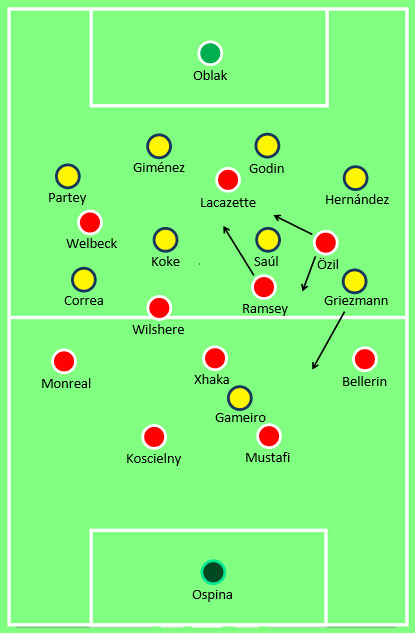
There is a clear contrast of styles (and performance) between these 2 teams. Arsenal sit 6th in the Premier League, way behind their top 4 rivals and have scored 66 goals and conceded 46 in 34 games. In the same number of games, Atlético have scored 54 and conceded just 18 and are 2nd in La Liga, behind Barcelona.
Despite their clear ability, Arsenal have tended to falter against better opposition in recent years, whereas Simeone’s team have relished the big games, always providing tough opposition even when underdogs.
First Half
Arsenal started well and were on top even before the red card. Atlético were uncharacteristically poor defensively and Arsenal created a few early chances. The sending off meant that Arsenal were only going to dominate even more and the pressure continued for the first half hour but they couldn’t take the lead.
Atleti then managed to gain some control and were containing Arsenal a bit better. They are known for their organisation but with 10 men, limiting Arsenal’s chances became their sole focus, meaning it perhaps wasn’t actually any easier for Arsenal to break them down. They defended in their usual 2 banks of 4, with Gameiro also dropping behind the ball, packing the space around the edge of the box and limiting space between the lines.
Second Half
Arsenal remained patient, working the ball wide and delivering plenty of crosses and after an hour, they got the opener. Wilshere crossed to the back post and Lacazette rose highest to make it 1-0.
Atlético’s approach didn’t change, however. In fact, Gabi came on for Gameiro, adding even more solidity to midfield, with Griezmann now playing as the lone forward. They knew that this was a game they couldn’t win but, if they could keep the score at 1-0, they would give themselves a chance to overturn the deficit next week in Madrid.
Stefan Savić came on for Correa and went to right-back, where Partey had struggled a bit – another defensive move. As 80 minutes went by, it looked like they might hang on for what would be an excellent result, under the circumstances.
But then, out of nowhere, came the equaliser. A long ball over the top to Griezmann, a mistake by Koscielny, Ospina saved the initial shot but Griezmann lifted the ball over Mustafi on the line. Griezmann was the only Atlético player in Arsenal’s half, about 30 yards away from any of his team-mates and Arsenal had plenty of men back, yet somehow allowed him to score from here. Monreal plays him onside but doesn’t cover round.

This was really all Atleti could have hoped for – a mistake, a chance from nothing – and they got it. They would have been thrilled to have only been a goal down but they now go into the second leg level and favourites to reach the final.
It was, perhaps, somewhat typical of both teams. Atlético dug in, hung on and took advantage of the only real opportunity they had while Arsenal should’ve won the game comfortably but one momentary lapse cost them.
Conclusion
An early red card meant that Arsenal totally dominated the game, with Atleti resorting to limiting their chances as much as they could. Arsenal still created enough chances to win the game (they had 28 shots to 6) and should be taking a lead to Madrid but a costly mistake means they now face a difficult task to reach the final in Lyon.
0 notes
Text
Bayern Munich 1-2 Real Madrid – Tactical Review
Line-Ups
Bayern were without David Alaba, Arturo Vidal and Kingsley Coman due to injury. Arjen Robben went off injured after just 5 minutes and was replaced by Thiago Alcántara, which meant Thomas Müller went out to the right. Zinedine Zidane left out Bale and Benzema, with Isco on the left and Lucas Vázquez on the right. Cristiano Ronaldo was in the central striker role.
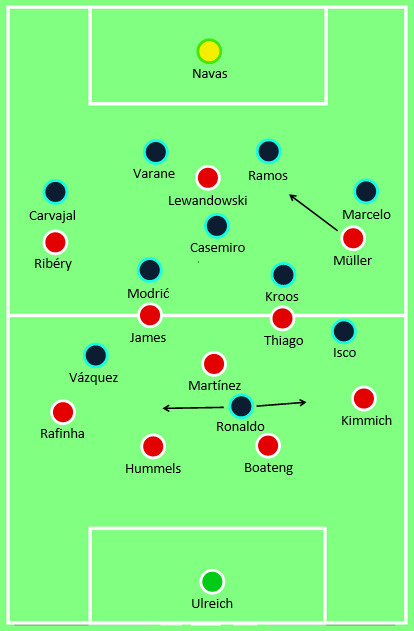
First Half
In contrast to the other semi-final, between Liverpool and Roma, neither team wanted to give up too much space here. Both were playing 4-3-3 and generally maintained their shape, not committing too many men forward. The central midfielders rarely ran ahead of the ball and the wide players were disciplined in tracking back.
Bayern dominated possession, with Real making it difficult, quite happy to sit back and look to play on the counter for the most part. Bayern did manage to get plenty of crosses in though, with Ribéry looking the most likely to create something, appearing to have the better of Carvajal.
Ronaldo was somewhat isolated and tended to drift wide – this created an early opening when he dragged Boateng wide and Kroos ran into the space between the centre-backs but this didn’t happen often enough. He also looked to get in behind – Modrić played a delightful ball ‘round the corner’ into the inside-right channel and went for the return pass but Ronaldo couldn’t find him. However, their attempts to feed him with through balls tended to be more hopeful.
Bayern did catch Real a bit unorganised, though, to open the scoring. Marcelo had made a forward run and was still out of position, Sergio Ramos was dragged wide and nobody tracked Joshua Kimmich running into the space behind him. From a tight angle, it looked like he would square it but instead he found the net (I’m not convinced he meant it).
Bayern then suffered another injury as Jérôme Boateng went off for Niklas Süle.
Another quick attack from Bayern after winning the ball in Real’s half lead to a great opportunity for Ribéry but his touch let him down. They were finding it difficult to break Real down when they had men behind the ball so their best chances came from direct counters.
Having created little of note in the first half and with just a few minutes remaining, Marcelo eqaulised with a great strike from the edge of the box. There was nothing exceptional about the build-up other than it was Ramos (centre-back) who played the cross-field ball to Carvajal (right-back) and he headed it back across to Marcelo (left-back). After playing the initial pass, Ramos also tried to join in with the attack.

Second Half
Marco Asensio replaced Isco at half-time, demonstrating Zidane’s lack of satisfaction with their first-half performance. It wasn’t that Isco had been particularly poor but it seemed like Real would benefit from having someone more direct out wide.
With Bayern continuing to be on top, it was indeed a direct attack which gave Real the lead, although it came from an awful mistake by Rafinha. From a Bayern corner, Rafinha gave the ball straight to Asensio, leaving a 2v1 against Kimmich. Asensio gave it to Vázquez and got it back running through on goal and made it 2-1.
Carvajal then got injured and, strangely, Zidane replaced him with Benzema, moving Vázquez to right-back. Considering he had 2 defenders on the bench and the fact they were leading the game, this seemed an odd move but Vázquez coped well enough.
As Bayern pushed for an equaliser, Real did have a few dangerous-looking counters and Bayern had to be wary of leaving themselves open. They did create chances though, with Lewandowski probably having the best when Corentin Tolisso (on for Javi Martínez) slid a nice through ball behind Ramos but he couldn’t finish. It was to be a frustrating night for the German side as it finished 2-1 to Real Madrid.
Conclusion
Neither team really showed a great deal of quality here, considering the players on the pitch, in a somewhat cautious game. Robben was a big loss for Bayern, who dominated possession but didn’t quite do enough with it. However, they surely deserved a draw, with Rafinha’s mistake effectively the difference and leaving Bayern with an uphill task next week at The Santiago Bernabéu.
0 notes
Text
Liverpool 5-2 Roma – Tactical Review
Line-Ups
Jurgen Klopp went with the same team which beat Manchester City 3-0 at home, with Milner preferred to Wijnaldum in midfield. Eusebio Di Francesco opted for a 3-4-3 – the same shape which saw them pull off an incredible comeback against Barcelona two weeks ago, although Cengiz Ünder started in place of Patrik Schick.

First Half
The decision to go with a 3-4-3 was immediately intriguing because it seemed that it would have to be more of a back 5 given Liverpool’s front 3 but Roma aren’t usually a team to sit back – they like to press.
And they did start positively. They pressed Liverpool, disrupted their passing somewhat and the wing-backs were moving forward, with plenty of space in front of them. The opening 20 minutes were fairly even.
Oxlade-Chamberlain went off with what appeared to be a serious injury after just 18 minutes and was replaced by Wijnaldum.
It became clear that Liverpool were prepared to allow Roma’s wing-backs space and leave the front 3 forward (as they generally do), hoping to catch Roma on the break, while Roma were seemingly prepared to defend 3v3. Their back 3 were pushing up incredibly high though, leaving a lot of space in behind, and this began to cause them problems.
The first big chance came when Liverpool broke quickly and Mané ran through but lifted the ball over the bar. Here we see Roma’s 3-4-3 shape and how high the back 3 are. There’s no immediate threat when Liverpool win the ball back but there is so much space in behind – it’s a dangerous game to play.
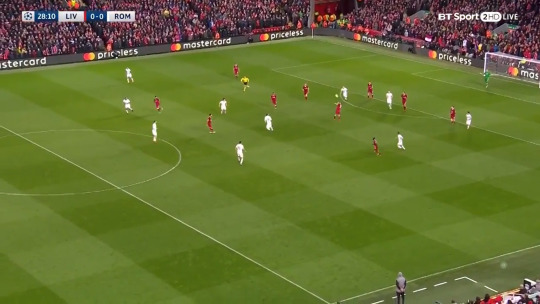
Shortly after, Liverpool were in behind again – they seemed to have gained better control in the game and figured out that they could easily exploit Roma’s high line. They weren’t pressing anyway near well enough to get away with it. They continued to look for balls over the top and down the channels and were causing problems.
It didn’t take long for Liverpool’s pressure to result in a goal. Henderson nicked the ball off Džeko in Roma’s half, with Kolarov moving forward to provide support. This left a big gap on the left side of Roma’s defence, which they never recovered from. Salah received the ball on the right-hand corner of the box and was allowed to cut onto his left foot and curl the ball superbly into the top corner. It was a fantastic finish but you can’t allow players of his quality so much time and space in the box.
A couple of minutes later, Lovren headed onto the crossbar from a corner. Roma were marking zonally and just allowed him to walk into position and have a free header. The same happened again shortly after and again Roma got away with it.
Firmino often dropped deep to receive the ball and one of Roma’s back 3 would usually follow him, creating even more space for Salah and Mané to run into. Wijnaldum was also making forward runs from midfield, sometimes beyond Firmino.
Just before half time, Liverpool broke quickly again and Salah doubled their lead. Virgil van Dijk cleared the ball and Salah controlled the ball into Firmino’s path. It was 3v2 in Roma’s favour this time but Firmino wriggled past Manolas on halfway and Roma were in trouble. He slid through Salah, who was far too quick for Fazio and Jesus and he dinked it over the onrushing Alisson.
Liverpool’s front 3 were simply far too quick for Roma’s back 3. Their high line, combined with the lack of pace, the fact they were left exposed and were just poor individually, was disastrous.
Second Half
You felt that Roma had to change something at half-time. They couldn’t continue to be this open and it wasn’t like they were even looking dangerous themselves. However, the only change was Schick for Cengiz Ünder – the shape remained much the same and the back 3 continued.
So the game, unsurprisingly, continued in the same manner. Roma continued to make mistakes, giving the ball away in bad areas and leaving space in behind.
10 minutes into the second half, a simple ball down the line set Salah away and he squared it to Mané, who made it 3-0. Again, Kolarov is closing down Alexander-Arnold, leaving space behind him and you can see how high the line is. Salah is probably just offside but it was such a risky strategy.
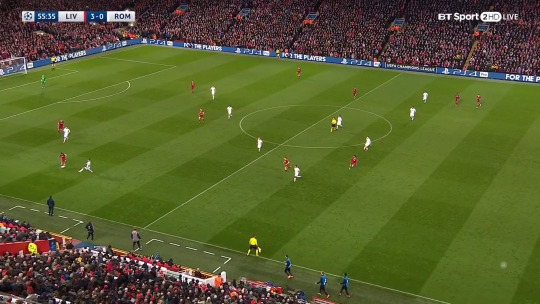
Just 5 minutes later, Salah again got in down the right, again behind Kolarov. He was 1v1 against Jesus, went past him so easily and squared the ball, this time for Firmino to make it 4.
Before the 70th minute it was 5-0, as Firmino headed in from a corner. I mentioned how poor their defending of corners was in the first half – this one wasn’t quite a free header but it wasn’t like it was brilliant movement and Firmino is hardly dominant in the air.
Liverpool seemed happy enough to settle for 5 goals and brought on Danny Ings for the star man Salah but with 10 minutes to go, Nainggolan’s excellent ball found Dzeko and he finished well. It was a good goal from Roma, even if it was poor defending from Lovren, although surely just a consolation.
But… shortly after, they were awarded a penalty and Diego Perotti made it 5-2 on the night. The tie still appears to be over but Roma overturned the same deficit at home against Barcelona in the previous round – they now have some hope at least.
We have seen Liverpool blow teams away on numerous occasions but they do tend to tire later in games, having spent so much energy early on. Of course it doesn’t really matter if the game is over by half-time but they let Man City back into the game when 4-1 up in the league. They appeared to ease off a bit at 5-0 but they don’t really know how to kill a game (or they just try to kill it by scoring more goals).
Conclusion
Eusebio Di Francesco went with a positive approach to the game but it was astonishing to see a team so easily exposed at this level. The decision to play such a high line and go pretty much man-for-man with Liverpool’s front 3 seemed, frankly, crazy. And then to continue like that when it so clearly wasn’t working was bewildering. For Liverpool, this was exactly what they would’ve wanted (space in behind) and they were able to play their normal game, attacking directly, with pace – they had far too much for Roma to handle. Liverpool will be wary of a miraculous comeback but, much like in the previous round, the tie should be as good as over after the first leg.
1 note
·
View note
Text
Newcastle United 2-1 Arsenal – Tactical Review
Line-Ups
Rafael Benítez, unsurprisingly, kept the same team that had won the last 3 matches. Arsenal, having played in Moscow on Thursday night and with little to play for in the league, were much-changed. Several regulars, including Özil, Ramsey and Koscielny, weren’t even in the squad, although Lacazette and Aubameyang both started. There were starts for Rob Holding and Calum Chambers in defence, while Joe Willock made his Premier League debut.
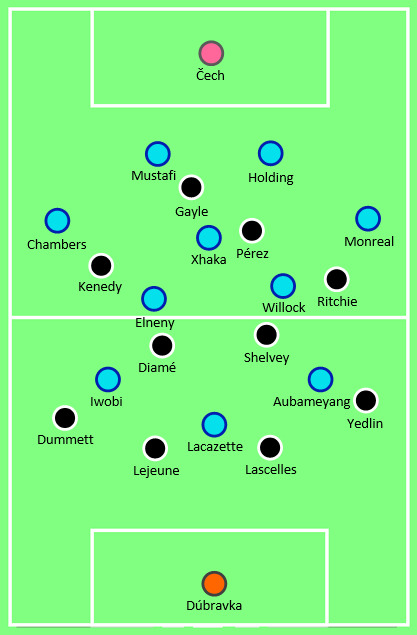
First Half
With Arsenal resting a number of key players, their midfield 3 was not the most creative you’ve ever seen but there was plenty of quality ahead of them. Lacazette was playing through the middle with Aubameyang on the left but, naturally a centre-forward, his instinct was to come inside and to run in behind.
He did exactly this for the opening goal; with Newcastle’s back 4 reasonably high up the pitch (leaving space behind) and no pressure on the ball, Mustafi played a ball over the top for Aubameyang to run onto. Yedlin is in the wrong position and doesn’t appear to be aware of the threat. Aubameyang times the run well, controls the ball and knocks it to the back post for Lacazette. It was a bit too easy but good play from 2 top-class players (and Mustafi) nonetheless.
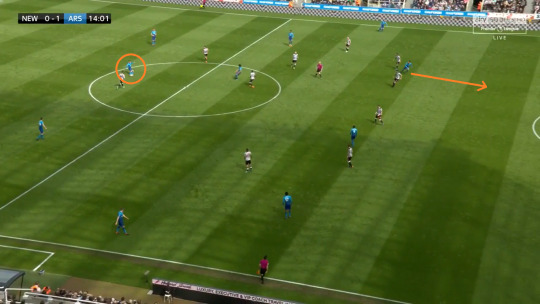
With Aubameyang looking to get in behind for Arsenal, Dwight Gayle was doing the same for Newcastle, with Jonjo Shelvey the supplier, looking to clip early balls over the top and turn Arsenal. He was given all the time in the world to do so here:
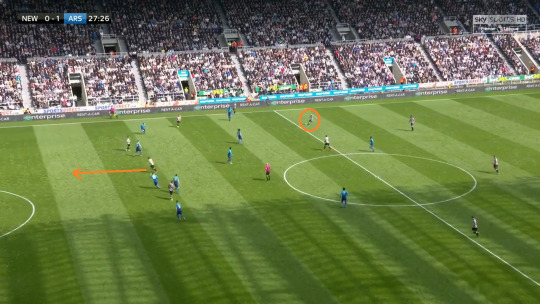
Shortly after, under more pressure but from a very similar position, he played the same ball again and this time it lead to the equaliser. Gayle got to the pass but was forced wide and played the ball out to Yedlin, who whipped it in to the front post. Pérez darted in front of Mustafi and hooked the ball round the defender and past Petr Čech at his near post. As Nemanja Vidić pointed out in the Sky studio afterwards, this was a very typical Newcastle move - we have seen this Shelvey-Gayle combination a lot over the last 2 seasons.
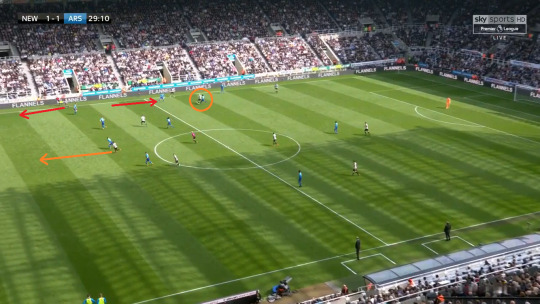
There was another signature Newcastle move in the build-up to the goal too. Kenedy (on the right at this point) dropped deep towards the ball, with Monreal following and Yedlin moved forward into the space behind him. Xhaka half-tracked him but when Gayle received the ball, Yedlin was free to pick out Pérez in the box.
Arsenal were dominating possession, as you would expect, and were largely on top in the first half. They had a couple of breakaways, which demonstrated the threat of their pace but lead to nothing. Calum Chambers had a good chance, not too dissimilar to the one Lacazette scored in fact, when a ball was clipped into the box and Mustafi headed it back across but Chambers couldn’t connect properly at the back post.
They then had a great opportunity when Diamé slipped and gave the ball away in a dangerous position, leaving Arsenal 4v3 but again the final pass was lacking. Arsenal certainly weren’t at their best but probably should have punished Newcastle with the quality they have. Instead, the teams remained level at half-time.
Second Half
There was a bit of a lull in the match at the start of the second half, with neither team really forcing the game. Newcastle were happy to soak up some pressure and Arsenal weren’t hurting them, moving the ball too slowly.
After an hour, Gayle was replaced by Slimani. Gayle had run the channels well but Slimani offers more power and physical presence. A few minutes later, Welbeck came on for Willock, signalling a change of intent from Arsenal. But Newcastle immediately scored a second.
The goal really comes from nothing as Newcastle have a throw-in near the halfway line. When Dummett takes the throw, you can see everyone has moved into a narrow space on Arsenal’s right side. Monreal, the left-back is about 15 yards from the touchline.
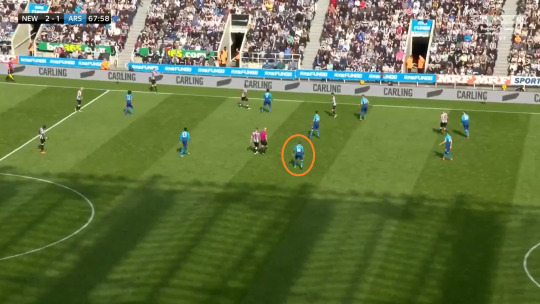
When Monreal goes to head the ball, the shape is much the same but now Monreal is moving forwards (to attack the ball) and therefore can’t cover the space behind him, which Ritchie and Pérez are moving into.
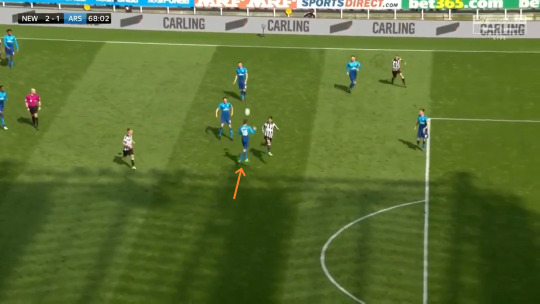
Slimani is first to react to the loose ball and spots the opportunity. He powers a header over Monreal towards Pérez. He helps it on to Ritchie, who controls and finishes with his right foot. Holding can’t cover round quickly enough but I would question whether Monreal needed to be so narrow to start with.
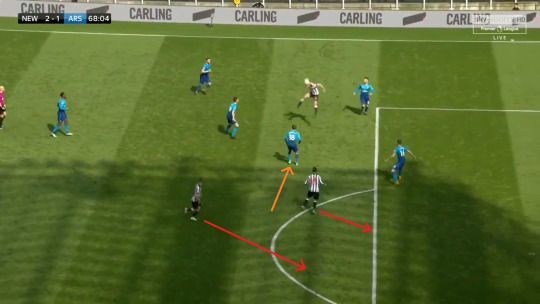
There were then 25 minutes left where you’d expect Newcastle to be hanging on but Arsenal really didn’t trouble them too much. Their away form is now truly abysmal. Having won 12 from 12 at home against teams below them, they have won just 3 away from home all season.
Having taken the lead though, you would still expect them to win the game. Newcastle had only won 1 game after conceding the first goal (West Ham away), losing 11 of 15 in total. Happier playing on the break, Newcastle tend not to be great when going behind, although Arsenal aren’t really going to change how they play at 1-0 up and you always feel they will give you chances.
Conclusion
This wasn’t Newcastle’s best performance but got back into the game by doing the things that have worked well for them all season – Shelvey’s direct passing combined with Yedlin’s overlapping run brought the equaliser. Arsenal, though missing key players, continue their woeful away form and Newcastle extend their run of victories to 4. Their Premier League status is now very much secure and a top half finish may even be on the cards.
#NUFC#NUFCFANS#afc#newcastle#united#arsenal#rafael benitez#arsene wenger#tactical#tactics#analysis#epl#premier league#jonjo shelvey
2 notes
·
View notes
Text
Newcastle United 1-0 Huddersfield Town - Tactical Review
Line-Ups
Rafael Benítez had no reason to change the team that beat Southampton so convincingly 3 weeks ago (and Manchester United in the previous home game), although Islam Slimani was on the bench for the first time since joining on loan. David Wagner, on the other hand, made several changes; Smith and Kongolo were at full-back, with Kachunga and van La Parra wide, meaning Tom Ince dropped to the bench. Laurent Depoitre was up front, rather than Steve Mounié.
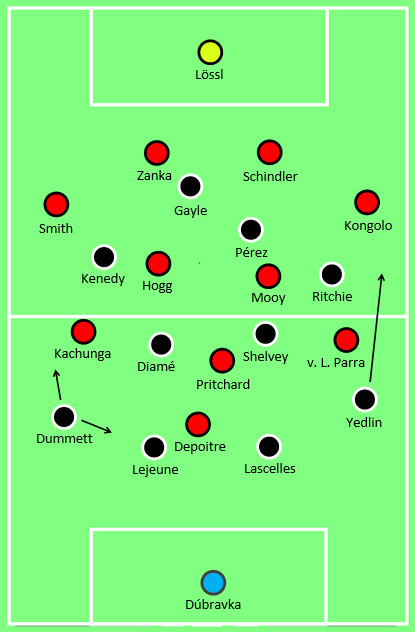
First Half
What was immediately striking was how much of the ball Newcastle were having. They have averaged 43.5% possession this season, according to WhoScored (only West Brom have averaged less) and even at home, have rarely dominated possession. Huddersfield have averaged 46.9% but clearly decided here that they were happy to sit off and allow Newcastle to have the ball.
This approach perhaps makes sense because Newcastle have generally been more comfortable when they don’t have a lot of the ball (hence the low percentage) and can play on the counter. They have sometimes struggled to break down a packed defence and look more dangerous when they can attack directly into space.
However, what was strange was just how much Huddersfield sat off. Newcastle’s centre-backs were put under no pressure whatsoever on the ball, even when stepping into Huddersfield’s half. Lejeune in particular was having an influence in the build-up, carrying the ball forward at times and looking to play incisive, forward passes.
Shelvey and Diamé were also taking it in turns to drop deep and pick up the ball, although Pritchard seemed to see Shelvey as the one to stop and was trying not to allow him so much time.
The other thing about Huddersfield’s plan was that they weren’t really offering a threat on the break either. Newcastle did protect against this somewhat by Dummett covering round, creating almost a 3 at the back at times in possession. Yedlin, much more of an attacking threat, was given more freedom to get forward on the opposite side, while Shelvey or Diamé would hold their position in front of the back 3.
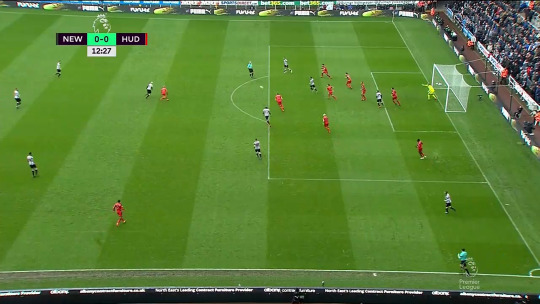
Perhaps Benítez wanted to ensure there was always an extra man against Depoitre and Pritchard, who often stayed relatively high, or maybe he was worried about the pace of van La Parra and Kachunga but Huddersfield just weren’t troubling Newcastle.
Newcastle created several chances, mostly for Dwight Gayle and mostly from crosses from the right. The best chance came when Shelvey played a quick free-kick in behind the Huddersfield defence for Gayle. He did well to bring it down and lifted the ball over Lössl but it went just wide.
Huddersfield did have one dangerous opportunity when Kenedy failed to track Smith and he fired a ball into the 6 yard box but it was cleared. In fact, Kenedy’s tendency to switch off defensively was just about the only thing that looked like it might cause Newcastle problems.
Newcastle had utterly dominated the first half but failed to take any of their chances and it remained 0-0. The worry being, of course, whether they could sustain this dominance as we have seen Newcastle tail off in the second half a few times.
Second Half
Newcastle weren’t quite so on top in the second half, although the pattern of the game was much the same and they continued to be the better team; they had to remain patient.
Huddersfield do have some good aerial threats, although they have only scored 4 set-piece goals all season. Zanka had a good opportunity from a corner but his header hit his own man. They did catch Newcastle on the break once, with a dangerous-looking 3v3, but Depoitre’s pass to Quaner was poor.
Atsu came on for Ritchie and shortly after, Slimani replaced Gayle to make his debut for Newcastle. Gayle had looked the most likely to score so it perhaps seemed a strange swap (Pérez may have been favourite to come off) but they are quite similar in that they both want to be in the box, on the end of chances. Differing styles but both very much number nines.
He quickly showed his willingness to run in behind as Shelvey again picked out an excellent ball over the top. Slimani got to the pass in the box but his touch let him down slightly.
Having dominated possession, the goal eventually came from one of the rare occasions Newcastle were able to win the ball and break quickly. Pérez released Atsu down the right and he clipped a ball towards Slimani at the back post. Lössl could only palm it to Kenedy, who showed great composure, simply squaring it to Pérez for a tap-in.
Huddersfield brought on Steve Mounié as a second striker and finally tried to cause Newcastle some problems, but to little effect. There were a couple of dangerous balls into the box but not too much to worry about in truth.
Wagner confirmed his game-plan afterwards, saying “Our idea was to frustrate them and sit deeper to minimise their clear-cut chances and hurt them on the counter-attack. In the first half Newcastle had good opportunities but in the second half I thought it was working for us.”
Huddersfield are the joint-lowest scorers in the league (alongside West Brom and Swansea) and have now failed to score in 18 of their 32 matches and 12 of their 16 away games. They had just 4 shots to Newcastle’s 18 and only 1 of those was in the box. The second half was better but they weren’t preventing Newcastle from creating chances and they simply don’t pose enough of a threat.
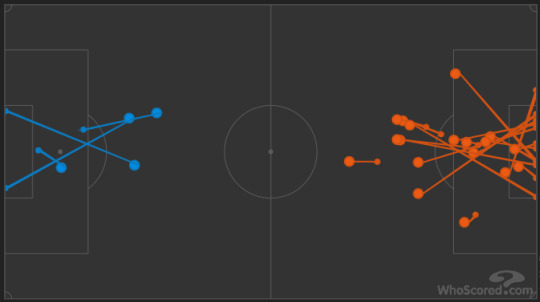
Conclusion
Huddersfield tried to sit back, frustrate Newcastle and hit them on the counter but in reality, didn’t do much of either. Newcastle thoroughly dominated, particularly in the first half, and it was a pretty comfortable victory in the end, even if they had to wait a while to go in front. The last 2 performances have been very impressive, in vital games, and now leave Newcastle United almost certain to remain in the Premier League.
#nufc#htafc#newcastle#united#huddersfield#town#rafa benitez#wagner#epl#premier league#tactical#review#analysis
0 notes
Text
Picking the England Squad
With the latest round of international friendlies done, Gareth Southgate has around 10 weeks until he names his final 23-man squad for the World Cup. England will then play friendlies against Nigeria and Costa Rica before heading to Russia. So who is likely to be on the plane?
The latest squad contained 27 players and that is without Harry Kane, so some names will need to be cut, one of which will be a goalkeeper. After years of Joe Hart being England’s number 1, his poor form means that the position has become a problem. Southgate picked 4 ‘keepers in his latest squad, with Pickford and Butland appearing to lead the way - it’s still not clear who is first-choice but Pickford’s superior distribution might see him edge it. He will then have to decide between Hart (his most experienced member of the squad) and Pope (yet to earn a cap) for the third spot.
Southgate is now set on playing 3 at the back, with England likely to set up in either a 3-5-2 or 3-4-3. Walker looked certain to be the right wing-back but was fielded on the right of the back 3 in both friendlies this week, with Trippier ahead of him. Danny Rose will likely be on the opposite flank, although he hasn’t played a lot of games this season. Ryan Bertrand is the obvious back-up but Ashley Young offers an alternative after some excellent performances at full-back for Man United.
The back 3 positions still seem very much up-for-grabs, with only Stones confident of his position. Phil Jones is still in the mix but Chris Smalling appears to be out of favour due to his lack of passing ability, while Gary Cahill, England’s most capped outfield player, lost his place in the latest squad. Southgate has called up several young defenders, handing debuts to Joe Gomez, Harry Maguire, James Tarkowski and Michael Keane, while Alfie Mawson was also called up but didn’t feature.
While these players have been rewarded for good club form and all are comfortable on the ball, they are very inexperienced at this level. Using Walker in the back 3 is likely an attempt to relieve some of those concerns, even if he seems somewhat wasted there. The option of playing a full-back as one of the outside centre-backs does offer some tactical flexibility, however. The versatility and suitability to a back 3 of Jones and Gomez may see them make the plane.
Central midfield is also a problem, with a distinct lack of quality in that area. Henderson and Dier took turns in captaining the side this week and are sure to be in the squad but there are some doubts over whether they should both be in the same team. Wilshere would add some creativity if he can stay fit, while Lingard and Oxlade-Chamberlain provide energy. Drinkwater would surely be in with a shout if he was playing more regularly while Delph has performed well for Man City but has also had injury problems.
Jake Livermore has been a regular in the squad recently and is a reliable option but you feel he would miss out if everyone were to remain fit. Ruben Loftus-Cheek was specifically named by Southgate as a player who would’ve likely been given a chance if it weren’t for injury (along with Jones and Delph) and may be seen as something of a wildcard after a promising performance on his debut against world champions, Germany.
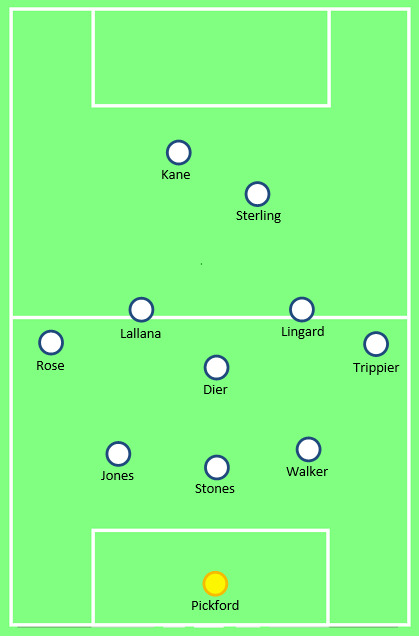
Southgate has tried 3 in midfield and 2 forwards but, with the lack of quality midfielders it might make more sense to play 2 in midfield and 2 more advanced players behind Kane. Playing 3 in midfield does perhaps mean that England could play 1 holding player with 2 ‘shuttlers’, similar to how Liverpool’s midfield has looked this season.
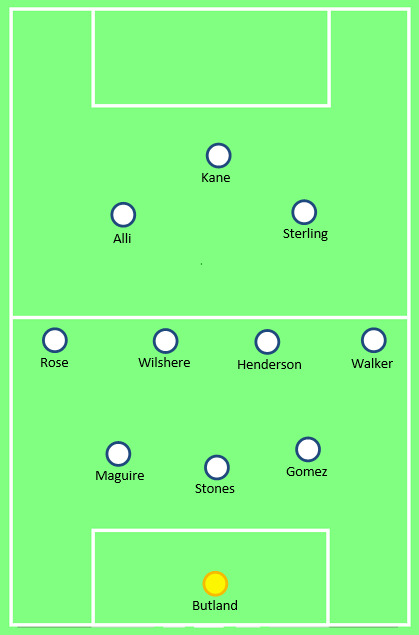
In the attacking positions, England do have good options. Harry Kane has 24 Premier League goals already this season and will surely start up front, despite his recent injury. Dele Alli has a good relationship with his Spurs teammate and Raheem Sterling has been in excellent form for league-leaders Manchester City, with these 2 likely to play behind Kane. Lallana has had injury problems but is another favourite of Southgate’s and provides real creativity and technical ability (and is the most similar to Kane’s other club-mate Christian Eriksen).
There is an argument for trying to replicate Spurs’ style to some extent and take advantage of their familiarity with each other, given 5 of their players are in contention to start (plus Kyle Walker who left there last summer). Spurs have also regularly played a back 3 in the last couple of seasons, with the full-backs being an important weapon in attack.
Jamie Vardy and Marcus Rashford offer pacey alternatives in attack, while Danny Welbeck is likely next in line. He has more international goals than anyone else in the squad (Jermain Defoe is the only current player with more) but does need more game time. It seems unlikely that any other forwards will be able to force their way into the squad before the summer.
Of course, injuries are likely to impact the final squad but Southgate claims he knows “19 or 20” of his squad already. There is still time for some players to stake their claim with some good form and some who need to play regularly in the final few weeks of the season, though it feels like your chances are slim if you haven’t been involved up to now.
One player who will be desperate to force his way in will be Theo Walcott, who is still yet to play in a World Cup, although Southgate has generally favoured youth. Ross Barkley is another who has been an England regular but injuries and lack of game time at Chelsea have hindered his chances.
However, the fact is, not all of his squad will be playing every game and on top form come the end of the season. A combination of these factors will need to be considered, as Southgate has alluded to, and the players that he knows and have performed well for him will have an advantage when it comes to his final list.
0 notes
Text
Newcastle United 3-0 Southampton - Tactical Review
Line-Ups
Jonjo Shelvey was fit to start so Benítez was able to name the same team that played against Man United and Bournemouth – this appears to be his strongest 11. James Ward-Prowse was on the right for Southampton, rather than Josh Sims, while Pierre-Emile Højbjerg partnered Mario Lemina in midfield instead of Oriol Romeu.

First Half
Newcastle got off to a dream start, in what was a massive game, as Kenedy put them ahead after 63 seconds. Shelvey lofted a ball over towards the Brazilian; it wasn’t even a particularly dangerous ball but Kenedy’s control and turn with his chest created the opportunity, even if the finish wasn’t quite so silky.
Dwight Gayle had a great chance to double the lead just a couple of minutes later, after Shelvey’s early throughball, but his control let him down. It quickly became clear that the plan was for Shelvey to knock the ball in behind as early and often as possible, much like against Bournemouth. Some balls were more hopeful but at worst it was giving Southampton’s defence, who have been prone to occasional errors, something to deal with. Gayle was offering a threat in behind and Newcastle were quite prepared to then compete for the second ball and prey on any mistakes.
With Shelvey the creator, Diamé was tasked with disrupting Southampton’s play, as has been his role in recent weeks. He was constantly closing people down, getting tight and sticking his foot in where possible. He got away with a couple that looked like fouls but he used his physical presence really effectively and the amount of ground he was covering was impressive.
This contributed to what was a wider problem for Southampton; they were having plenty of the ball but weren’t doing anything effective with it. Time and again they looked forward and didn’t see anything on, often then resorting to going backwards, sideways or forcing the pass and giving it away.
At one point, Diamé won the ball deep inside his own half from Højbjerg and initiated an attack. It quickly came to nothing but when Lemina received the ball in the Southampton half a few seconds later, Diamé was there again to close him down. Lemina took too long on the ball, struggling for options and Diamé nipped in to poke the ball away from him and into Gayle’s path in a dangerous position. Gayle, with Pérez to his left, had another good opportunity to get the second but didn’t make the most of it. However, this nicely summed up Southampton’s issue and Diamé’s impact.
Having said that, Southampton do have a talented squad and did play some nice stuff at times. One of their best moves lead to a corner, from which Newcastle broke and scored the second. The ball was headed out towards Lemina on the edge of the box, who slipped trying to shoot, allowing Pérez to break with the ball. He carried it well into the Southampton half before waiting for the perfect moment to slip it to Gayle, who had made a lung-bursting run to get up in support. You might expect Gayle to shoot but he unselfishly puts it on a plate for Kenedy. It was the kind of situation that Newcastle have wasted on occasion this season, but this was an utterly clinical counter-attack.
Second Half
At half-time, Pellegrino made a double substitution; Sims and Long replacing Lemina and Tadić, with Ward-Prowse moving central. Lemina had had a tough game and this meant a switch to 4-4-2, some added pace and the intention of being a little more direct.
However, it took little more than 10 minutes for Newcastle to get the third goal. Shelvey was looking to shoot, just outside the box, on the left hand side but eventually poked the ball sideways to Ritchie, who stroked it low into the bottom left corner. Ritchie was stood in acres with his arms in the air for ages, screaming for the ball, but none of the Southampton players seemed to spot him, with Ward-Prowse and Højbjerg both drawn towards Shelvey.
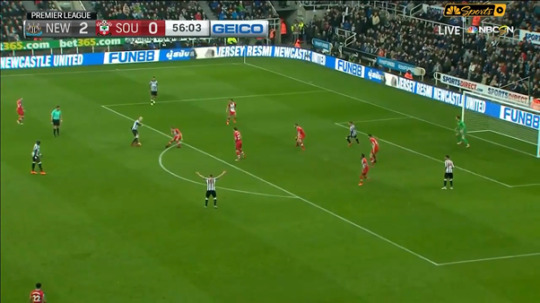
The game was effectively done at this point, as Newcastle saw out the remaining 35 minutes comfortably.
Conclusion
Newcastle have wasted some good opportunities to win games this season but, in a huge game against one of their relegation rivals, this was a comfortable, clinical victory. Southampton were poor but Newcastle took advantage of their mistakes and capitalised on their early lead, with Shelvey and Diamé again key in gaining control. Newcastle, now 5 points clear of the relegation zone, will feel much more confident of survival, while Southampton are concerned enough to have elected to change their manager.
#nufc#saints#newcastle#united#southampton#benitez#mauricio pellegrino#rafa#jonjo shelvey#epl#premier league#tactical#review#analysis
2 notes
·
View notes
Text
Newcastle United - Statistical Review 17/18, Part 3
After an excellent start to the season, Newcastle then went on a disastrous run of 1 point from 9 games. After 18 games, they sat on 15 points and had just slipped into the bottom 3 after defeat at Arsenal. Since then, in the last 11 games, Newcastle have only lost 3 times (twice to Man City and away to Liverpool at the weekend), picking up 14 points (3 wins and 5 draws).
Now on 29 points from 29 games, Newcastle are in 16th, just 2 points clear of the relegation zone, with the bottom of the table still incredibly tight.
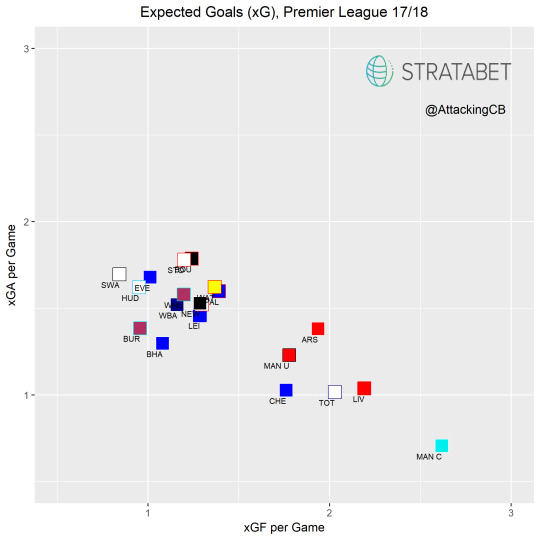
The xG table still shows what has been clear all season – there is very little between the bottom 14 teams. But, at this point, with 9 games to go, other factors are more important – number of points on the board, fixtures and form.
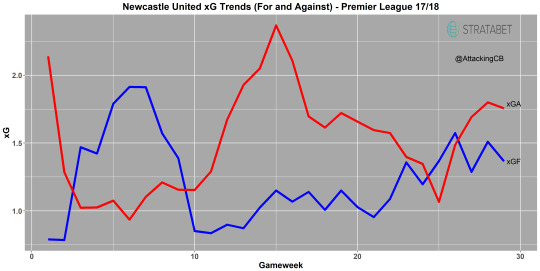
(5-game rolling average)
After a great start, Newcastle’s performance dropped off significantly, resulting in their awful run of form. However, in recent weeks, attack and defence have converged to much more respectable levels. January loan signings Kenedy and Dúbravka have both added something to the team and if they can maintain these numbers, they should be in pretty good shape.
The only disappointment from recent games is that they haven’t converted enough of these good performances into wins, with draws against Brighton, Swansea, Burnley, Palace and Bournemouth. Especially considering the late goals conceded against Burnley and Bournemouth.
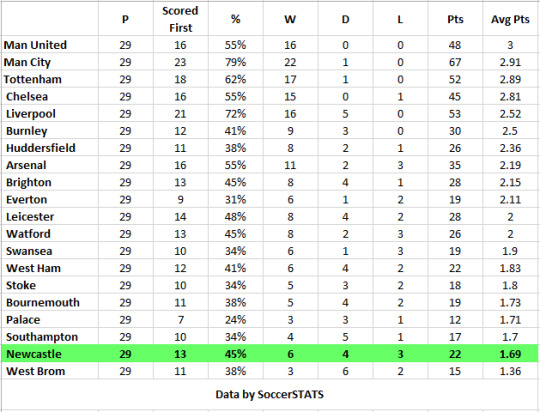
In fact, only West Brom have a worse points conversion rate after scoring the first goal. Despite scoring first in 13 games, Newcastle have only turned 6 of those into wins.
Fixtures
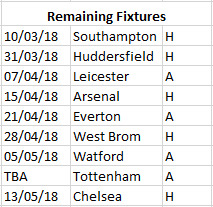
Newcastle don’t have the easiest of run-ins but 3 massive home games against teams around them offer great opportunities for 3 points. There are no guarantees though and we often see strange results - the end of the season can sometimes be a good or bad time to play teams, depending on whether or not the game means something to them - so don’t be surprised if the points are gained from unlikely sources. A slight concern might be that Newcastle didn’t beat any of their remaining opponents in the reverse fixtures (gaining 2 points in total).
One positive for Newcastle is that they don’t have many injury concerns. Jonjo Shelvey picked up an injury against Bournemouth and is likely to miss the next game while Islam Slimani is yet to make his debut but should also be fit for the Huddersfield game. He is likely to play a maximum of 7 games and may not be up to speed but he could still add something in front of goal.
Chances of Survival
West Brom are almost gone, with Newcastle 6th favourites to take one of the 2 remaining relegation spots (behind Stoke, Palace, Huddersfield, Swansea and Southampton), but it is very tight between those 6 and West Ham (just 3 points separate them). It’s looking like the safety mark will be around 37 points, which would leave Newcastle needing 8 more points, although you’d feel much safer on 40 points and not relying on other results. Newcastle also have a superior goal difference to all of their rivals apart from Southampton, which could come in handy.
I would suggest that Newcastle should have enough but it is likely to remain tight and could well be a nervy couple of months. Rafa has spoken regularly about the lack of experience in his team and not seeing out games is perhaps evidence of that. He will hope that they have learned their lessons because, at this stage of the season, you can’t afford many slip-ups.
This article was written with the aid of StrataData, which is property of Stratagem Technologies. StrataData powers the StrataBet Sports Trading Platform, in addition to StrataBet Premium Recommendations.
0 notes
Text
Bournemouth 2-2 Newcastle United – Tactical Review
Line-Ups
Eddie Howe reverted back to a back 4, having switched to a back 3 in recent weeks (with mixed results). Josh King came in for the injured Jordon Ibe and Defoe was on the bench after a lengthy layoff. It’s rare for Rafa Benítez to pick the same team for 2 games in a row but after the last performance against Man United and 2 weeks rest, there was no need to change anything.
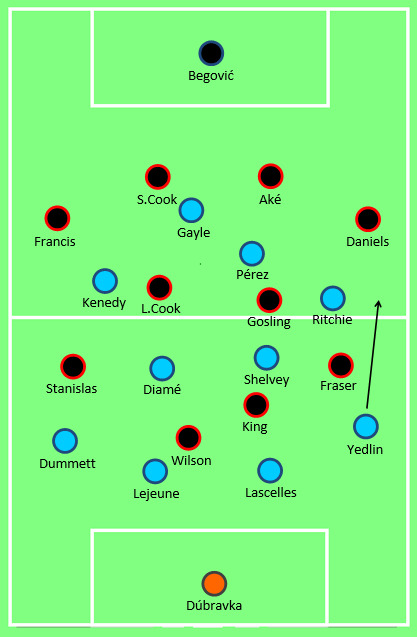
Newcastle Dominate Right Flank
After 16 minutes, Shelvey’s excellent early pass in behind Charlie Daniels released Ritchie, who squared for Dwight Gayle to put Newcastle ahead. Newcastle had already tried to get in down the right a few times and continued to look for this ball. On this occasion it was Ritchie but it seemed like the plan was actually to utilise Yedlin.
Bournemouth like to play positively and were holding quite a high line so Newcastle looked to play it forward quickly and exploit the space in behind. In particular, Yedlin looked to burst forward as soon as Newcastle won the ball back. Ryan Fraser was caught ahead of the ball a few times and often drifted central and therefore wasn’t in a position to immediately track Yedlin, which left Daniels facing a 2v1.
We have seen before how much of a threat Yedlin’s pace can be and he actually looked to run beyond Ritchie, with Shelvey looking to hit that channel as soon as possible. Such was the determination to do so, Shelvey even played one ball into this area when no-one was actually there. Of course this leaves a gap at right-back, so it’s about choosing the right moments to attack and Bournemouth weren’t able to exploit this.
The other big problem for Bournemouth was that they weren’t able to get the ball into the forwards. Lascelles and Lejeune were sticking so tightly to King and Wilson, not allowing them to receive the ball to feet. Newcastle were also closing Bournemouth down quickly in midfield once they entered the Newcastle half, Benítez encouraging his team to work hard and maintain the intensity of the Man United game.
Right on half-time, Pérez’s low cross went through Begović and again found Gayle, who tapped in for his second (from a combined 3 yards).
Second Half
At half-time, Adam Smith came on at left-back for Daniels, who had clearly been struggling to cope with Ritchie and Yedlin. Junior Stanislas also came over to that side as Howe looked to shore up that flank.
The pattern of the game continued, with Newcastle still looking comfortable. They were having less joy down the right but with a 2-goal lead, were now even happier to play on the counter. As the game went on, Bournemouth pushed more and more and Newcastle were getting chances on the break, particularly after Atsu replaced Kenedy, who had been quiet. Bournemouth were having to defend 2v2 on the halfway line at times, with Newcastle looking to move the ball forward at pace.
Bournemouth Resurgence
Mousset and Defoe came on and Bournemouth had a spell of pressure, on around 75 minutes, with a succession of corners. Hayden came on for Dwight Gayle, who had complained of a tight hamstring and you sensed Rafa was preparing for a late onslaught.
But following this, Newcastle had their best opportunity to kill the game when Atsu went through and squared to Shelvey, only for him to slice it wide. Credit to Nathan Aké for getting back to put Shelvey under pressure but he and Atsu should’ve been more clinical.
Almost immediately after, Bournemouth went up the other end and scored and it was game on with 10 minutes to go. Shelvey was caught sleeping but it should be noted that he had just made a run into Bournemouth’s box for the chance and was shattered after running back. He was also now playing further forward as part of a 3-man midfield and Smith was not his man. Shelvey should do more but Hayden and Diamé also dropped too deep, leaving a big gap for Smith to move into. On top of all that, it’s simply a great hit.
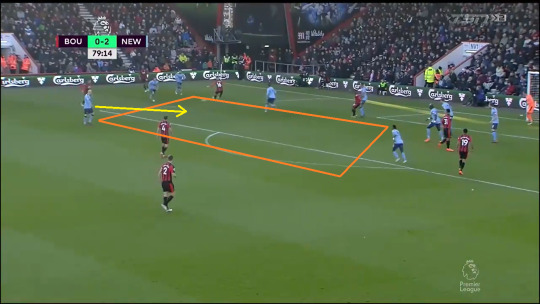
Bournemouth, now believing that they could get something from the game, were really going for it and taking risks. Newcastle still looked like they could finish the game on the break but they were having to withstand some pressure.
The pressure mounted and in the 89th minute, Bournemouth equalised. Again, Shelvey was criticised for declining his responsibilities. This time he was back in the box, raced out to close 2 Bournemouth players down but then stood and watched as Gosling snatched a point. I pointed out that he was playing more advanced and there were plenty of men back but it wasn’t like he was playing as a forward and this was late in the game – I’m not sure it would have made a difference but he surely had to be helping out.
There are 5 Bournemouth players in the middle of the box here, plus the man on the ball, and 7 Newcastle defenders. However, as the ball was crossed to the back post, FOUR Newcastle players went towards it, leaving Gosling unmarked in the middle. Perhaps there was an element of panic causing them to rush towards the ball.
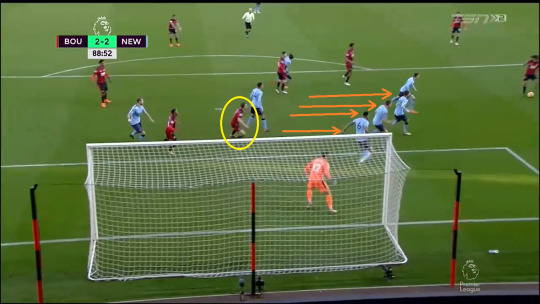
Bournemouth sensed a winner and continued to push but the game finished 2-2.
Substitutions
Rafa Benítez has been criticised for his substitutions, with suggestions that they were too negative. Atsu for Kenedy was like for like and had a positive impact on the game but there’s a case for the other 2. Gayle was taken off as a precaution but it did seem somewhat negative at a time when Newcastle were in control of the game and were threatening on the break. The options were limited but you felt Pérez wasn’t really going to offer enough on his own and maybe Joselu would’ve been a better option to hold the ball.
Manquillo also came on for Ritchie, another defensive move but without Murphy on the bench, again there was a lack of choice. It isn’t clear whether this move was forced or not and I don’t think it really affected the game but it does seem a strange move to leave Murphy out when Kenedy and Ritchie are the 2 most likely to be taken off.
Conclusion
Yet again, it was a game of 2 halves for Newcastle and another lead that wasn’t converted into a win – in this case, 2-0 up with 10 minutes to go, it is even harder to take. The game should have been over but you should also be able to defend a 2-goal lead. After using Ritchie and Yedlin to dominate the right flank in the first half, Bournemouth rescued a point after a late resurgence. I don’t think this was a case of Newcastle switching off so much as it was Bournemouth throwing everything at them and not coping very well. They were forced back and made some errors and perhaps a lack of experience was their undoing again.
0 notes
Text
Newcastle United 1-0 Manchester United – Tactical Review
Line-Ups
Rafa Benítez made 2 changes to the team which drew with Crystal Palace last week, bringing in Florian Lejeune for the injured Ciaran Clark and handing new signing Martin Dúbravka his debut in goal. José Mourinho went back to the team which lost to Tottenham at Wembley 2 games ago, although injuries limited his options.
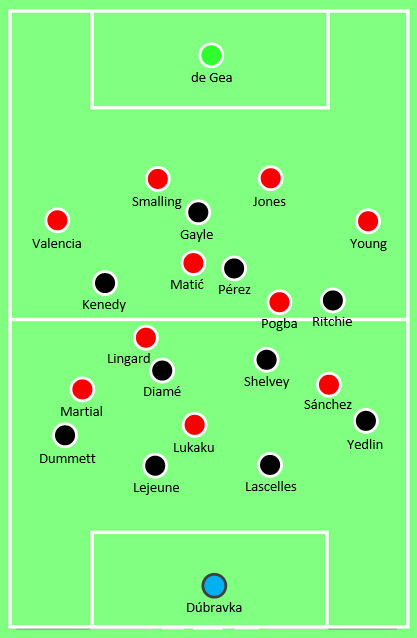
First Half
Newcastle started the game on the front foot and Shelvey forced an excellent save from de Gea after just 5 minutes. They continued to push though, pressing Man United quite aggressively, getting tight when possible and pushing up as a team, looking to maintain that pressure.
After about 15 minutes, Newcastle eased off a little, sitting back a bit more but still looking to engage. They couldn’t maintain that intensity for 90 minutes and were still respectful of the threat Man United pose.
Man United basically looked like a 4-3-3, although Lingard as the most advanced midfielder had a bit more freedom to drift and join the front 3. Their attacking players are all talented and have an abundance of pace and power but maybe lacked a passer in there to give them more control.
Midfield was the key area where Newcastle were able to get a foot in the game. They were getting in people’s faces (in particular, Diamé and Shelvey were trying to close down Pogba and Matić) whereas Man U were looking a bit too casual. Newcastle were disrupting them and forcing some errors but Man United were a bit sloppy.
Manchester United were still dangerous on the break the few times they managed to exploit the space behind Newcastle and move the ball forward quickly. Their best chance of the half came when Lukaku dropped deep, taking Lascelles with him and layed the ball inside to Matić, who had plenty of time and space to look forwards and find a pass. Martial and Lingard both made runs beyond Lukaku (with Shelvey having to track Lingard) and Matić slid the ball through to Martial for a one-on-one but Dúbravka made the save.
Second Half
Going into half-time at 0-0, the concern for Newcastle was whether they could maintain the effort levels of the first half and whether Man United would find another gear. They did up it, starting the second half well and had a spell of sustained pressure. Newcastle were finding it harder to get out and keep the ball but they were still trying to be positive.
The intensity was better from Man United and they started to get tighter to Newcastle, not allowing them time to play. The best chance of the game came when Valencia got tight to Pérez inside Newcastle’s half and won the ball. Lukaku slid it through to Sánchez, who rounded Dúbravka to leave the goal open but just delayed his shot and allowed Lejeune to get a block in.
It was Newcastle who took the lead, however. Shelvey floated a free-kick to the back post, Lejeune rose highest to head the ball on and Gayle cleverly knocked it back into Ritchie’s path.
It was well-worked from Newcastle but it was a poor goal to concede from Manchester United’s point of view, especially as the free-kick wasn’t even from a dangerous position. Ashley Young was screaming at Lukaku to come back and help – it may not have mattered but he didn’t seem to realise he was required and was late getting into position. They then allowed Lejeune a free header, didn’t win the second ball and Ritchie was able to stroll into the box unmarked and have a free shot from 12 yards out.
Mourinho had been preparing to make a change before the goal but brought 2 subs on anyway – Carrick and Mata replaced Pogba and Lingard. Pogba had an issue in the warm up and didn’t look quite right all game. Mourinho said he added Carrick for his ‘simplicity’ in possession – he is excellent at advancing the ball from deep and played a sublime pass through to Ashley Young. Mata went over to the right, which meant Martial went to the opposite side and Sanchez moved central.
Man United were now in a 4-2-3-1 shape and the full-backs were pushing on and providing the width, with Sánchez and Mata in particular wandering and dropping deep, trying to create something.
Due to injuries, Man United’s options from the bench were limited, with Mata the only real potential game changer. It was also notable that Mourinho substituted all 3 of his midfielders (later bringing on McTominay for Matić), emphasising the issues they had here.
Newcastle were being pushed back, were tiring and were struggling to keep the ball but they now had a lead to protect and the end was in sight. It was a surprise that Benítez waited until 80 minutes to make a sub when his team were clearly tiring but he was probably reluctant to disrupt the shape of the team, given how well they were doing.
They had to ride their luck a little - Martial had 2 shots in quick succession blocked by Gayle and Dúbravka made a crucial save (capping a tremendous debut) – but they were “fighting like animals” as José put it and managed to hang on for a vital win.
Conclusion
Everyone noted how cautious Newcastle were against Man City, basically just trying to stay in the game for 75 minutes and then hoping to nick something but this was a completely different match. They were positive and aggressive, but also disciplined, looking to cause Man United problems rather than just soaking up pressure. Mourinho was full of praise for Newcastle’s fight and while their tactical approach was spot-on, that’s largely what this result was about – fight.
#nufc#mufc#newcastle#united#manchester united#rafa benitez#jose mourinho#paul pogba#alexis sanchez#epl#premier league#tactical#analysis#review
0 notes
Text
Crystal Palace 1-1 Newcastle United - Tactical Review
Line-Ups
With a host of injuries, James McArthur started on the left for Palace, with Zaha in a sort of roaming forward role. Martin Kelly remained at centre-back with Mamadou Sakho on the bench after some time out injured. Islam Slimani was unable to make his debut and Joselu was ill, so Gayle started up front with Pérez behind, while new goalkeeper Martin Dúbravka was on the bench.
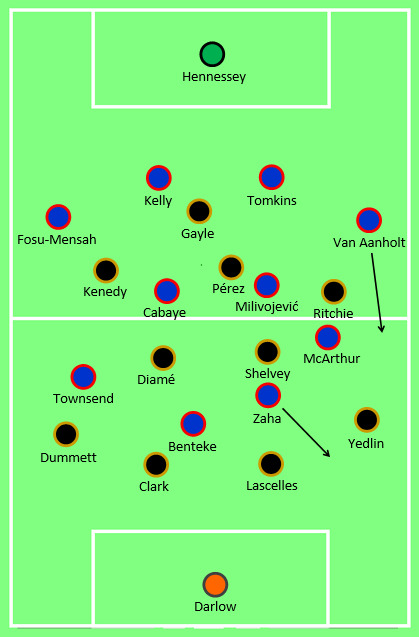
First Half
There was an early worry for Newcastle when Zaha managed to receive a through ball between the 2 centre-backs but Lascelles managed to cover round. This was an early indicator of the main threat. Zaha has clearly been Palace’s most dangerous player this season and appears to have upped his game in the last year or so, impacting games on a more consistent basis.
McArthur, usually a central midfielder, was playing a narrow role on the left, which did allow Yedlin some opportunities to get forward in support. Zaha was also drifting to the left but had more freedom in this forward role and was also making some runs in behind.
There was another chance for Palace to exploit a gap in Newcastle’s back line when Lascelles lost the ball around halfway, leaving Clark massively exposed and Benteke in acres of space. Shelvey and Diamé failed to react to the danger but Dummett busted a gut to make up the ground and put enough pressure on Benteke.
It was Newcastle who took the lead though, when a Kenedy corner went through everyone and found Diamé at the back post.
There were a couple of important blocks and saves by Newcastle but they were also threatening, mostly through Kenedy. Similar in style to Zaha, he’s a quick, tricky winger with good feet and caused some problems when running at players. It was a fairly even game, with both teams creating good chances.
Second Half
Soon after the re-start there was a great opportunity for Newcastle to extend their lead when they broke from a Palace corner and ended up with a 2v1. Kenedy’s pass to Pérez was poor though and the move ended. It was notable that it was Zaha who chased all the way back to his own box and came away with the ball.
The key tactical change in the second half was that McArthur went into a central position, as the number 10, while Zaha moved wide left. His role wasn’t too different - he had been drifting wide anyway – but he now had that space to himself. In the first half, he had been causing some problems but that area seemed a bit crowded with McArthur there and van Aanholt getting forward.
Not only did Hodgson move McArthur, but it seemed like there was a conscious effort to get out of Zaha’s way and leave him isolated against Yedlin. And it worked. Zaha was seeing more of the ball, had more space to run into and was really impacting the game.
In fairness to Yedlin, Zaha is an incredibly difficult player to deal with 1v1 and he needed more support. Newcastle have had this problem before down the right (most notably against Watford), with Ritchie being guilty of not helping his full-back out enough. Van Aanholt was still getting forward, offering the overlap when possible, to add to Newcastle’s problems down that side.
After 53 minutes Zaha ran at Yedlin on the outside and got a cross in (Ritchie was actually helping out this time but it didn’t matter), which lead to a penalty for a shirt pull by Clark on Benteke. Milivojević equalised from the spot.
Crystal Palace were now well and truly on top and pushing for a second. Benítez replaced Kenedy with Atsu, wary that his team were struggling and perhaps not totally confident in the young Brazilian’s tactical discipline.
Newcastle weren’t helping themselves either. For all Palace were much improved, they couldn’t get hold of the ball for more than a few seconds – partly some good pressure from Palace but also some very sloppy passing. Gayle became more and more isolated (although there weren’t any real options to change it), the pressure mounted and Newcastle were hanging on. But hang on they did.
Return to Selhurst
To put the result into perspective, it is worth remembering Newcastle’s last visit to Selhurst Park in November 2015, which, for me, was the epitome of Steve McClaren’s spell as manager. Here’s how they lined up against Pardew’s Palace that day:

Dummett and Pérez are the only players to have started both games, although Mbemba and Elliot remain members of the squad. Similarly, Newcastle got an early lead, but not only did they not hang onto it, they found themselves 2-1 down just 7 minutes later! It was 3-1 by half-time and finished 5-1, as Newcastle completely capitulated.
This was a team which had more talent but made little attempt to frustrate the opposition and weren’t remotely capable of protecting a lead. In contrast, the current team found it tough in the second half this weekend; they were struggling, they lost the lead and could have lost the game but they stuck with it and ended up with a point. It may have been a missed opportunity to get 3 points, but this is a team that doesn’t lie down.
Conclusion
This was very much a game of 2 halves - the first half was fairly even and Newcastle managed to go into half-time ahead but the second half was almost all Crystal Palace. Hodgson’s switch to allow Zaha more space was a key change that allowed Palace to get on top and, even with a soft pen, they deserved at least a point and were unfortunate not to win the game in the end.
#nufc#cpfc#newcastle#united#crystal palace#palace#tactical#tactics#analysis#epl#premier league#roy hodgson#rafa benitez
0 notes
Text
Manchester City 3-1 Newcastle United - Tactical Review
Line-Ups
Pep Guardiola handed Oleksandr Zinchenko a first Premier League start at left-back, in place of the injured Fabian Delph. Other than that, Manchester City were as expected. Benítez went with the 5-4-1 that was utilised in the reverse fixture, with Hayden the surprise choice as the third centre-back.
Murphy was chosen ahead of Ritchie, presumably for the extra pace and Dummett and Manquillo were the ‘wing-backs’ - in reality, they basically played as regular full-backs in a flat back 5. Yedlin has been vulnerable defensively at times this season - it’s debatable whether Manquillo is any better but he is probably the more disciplined of the 2.
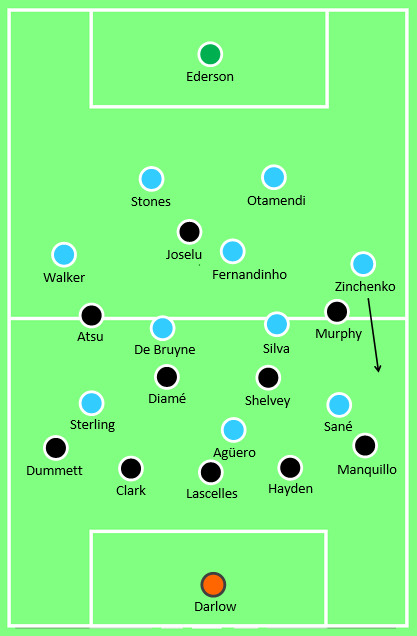
First Half
Bristol City and previous opponents Liverpool had some success (to different degrees) by pressing Man City high up the pitch, attempting to disrupt their rhythm. Liverpool, of course, ended their unbeaten run in the Premier League, while Bristol City caused some problems but also showed the dangers of an aggressive approach and ultimately lost the game and the tie.
Newcastle were unlikely to replicate that approach, generally being more comfortable allowing teams to come on to them. However, in the opening minutes they did attempt to press City high, closing them down on the edge of their own box, but City evaded the pressure with ease.
There was an early chance for Newcastle when they caught Man City sleeping from a free-kick, with Shelvey sliding a ball through to Atsu down the left. He crossed to the back post and the ball fell to Clark but he completely miscued with his right foot.
The early intent to push City back did not last long as Newcastle soon retreated into a deep block. The 5 across the back meant that the full-backs weren’t isolated against City’s wide men. If Sané or Sterling came inside, the full-back could pass them on to the outside centre-back and stay wide.
Hayden has played at centre-back before but has generally been in midfield for Newcastle and is more mobile than most centre-backs. He was therefore more able to deal with City’s movement. He and Clark were also happy to step out into midfield at times, knowing that there was extra cover behind.
Newcastle were making it hard for City but they were struggling to get hold of the ball for more than a few seconds. One of the first times they did break and get bodies forward, they gave it away, City broke into space and Silva found Sterling at the back post, who put the ball in the net. The linesman’s flag went up but it was a glimpse of City’s devastating efficiency when given space to run into.
Newcastle did press sporadically, looking to steal the ball high up or force a mistake when there was an opportunity but they weren’t fully committed to doing so, with only the front 3 or 4 players going. And every time they did they looked vulnerable, as City generally played around them comfortably, exposing the back 5.
Newcastle were trying to get closer to their opponents than in the previous game, with Diamé usually the one looking to step up and press City in midfield. This did force City back a few times but it also left a gap behind him - often Fernandinho was given time on the ball but if you close him down, this leaves more space for Silva and De Bruyne, who are much more dangerous.
City had a ton of crosses and corners in the first half, particularly down their left, but there were so many bodies in the box that it was difficult to pick anyone out. That being said, the first goal did in fact come from a cross from the left. De Bruyne whipped the ball in towards Aguero, who nipped in front of Clark and got enough of his hair on the ball to claim the goal.
Second Half
The game continued in much the same vein as the first half, with Newcastle continuing to frustrate Man City, who were totally dominating but weren’t creating a whole lot. Much like the match at St. James’, the longer the game went on at 1-0, the more you felt Newcastle had a chance of nicking a point late on.
However, shortly after the hour mark Sterling played a quick one-two round Manquillo, got in front of him and was brought down inside the box. Aguero stuck the penalty in and any hope of getting a result faded.
But, a few minutes later, Newcastle won the ball back on the edge of their box, Clark brought the ball out of defence, gave it to Joselu and then, somewhat fortuitously, got it back. He then played a sublime through ball to Murphy, who made a run in behind Zinchenko. With enough pace to get away from the young Ukrainian, he ran through on Ederson and coolly dinked it over the keeper.
Man City had made it really difficult for Newcastle to get out and have dealt well with counter-attacks all season but they do leave a lot of space behind if you can get through. Pep has worked a lot on making his teams less vulnerable to this but this goal did remind me of his Barca team, who would occasionally give away a really simple goal from nowhere, having absolutely dominated the game.
Newcastle were now trying to push for an equaliser. Yedlin was on for Manquillo, providing more of an attacking threat down the right, while Pérez and Gayle replaced Atsu and Joselu and Hayden moved into midfield. Diamé got into the box and forced a save (and a fumble) from Ederson, while a breakaway from a City corner had looked threatening.
However, they were clearly tiring and starting to leave space for City to exploit. The game became a bit end-to-end and, although Newcastle were at least threatening to nick a point, a third goal for City looked inevitable. On 83 minutes, Sané turned the defence inside-out, squared to Aguero, who wrapped up his hat-trick and the 3 points.
Conclusion
A very similar game to the reverse fixture at St. James’ park with Man City, unsurprisingly, dominating the game and Newcastle trying to stay in the game for as long as possible before a late push to nick something. They stuck to their task, remained disciplined throughout and weren’t out of the game until late on but in the end, City’s class and dominance told.
#nufc#mcfc#newcastle#united#machester#city#epl#premier league#tactical#tactics#analysis#pep#pep guardiola#rafa#rafa benitez
0 notes
Text
Are Sunderland Headed For League 1?
A massive win against Hull City at the weekend sees Sunderland move off the bottom of the Championship table, but they remain in the bottom 3 (on goal difference only) and the fear of relegation persists for a club who should not be in this position having been a Premier League team last season.
Simon Grayson was handed the task of rebuilding after relegation but was relieved of his duties after just 1 victory in the opening 15 games. Chris Coleman was brought in to save the season from disaster but, still in the relegation zone after 11 games in charge, has there been an improvement?
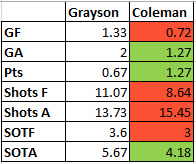
Per game comparison.
Well, firstly, Coleman has won 4 games, picking up 14 points, more than half of Sunderland’s total (25). He also appears to have tightened up the defence, but at the expense of the attack. The problem is that the teams around them have started to pick up points too.
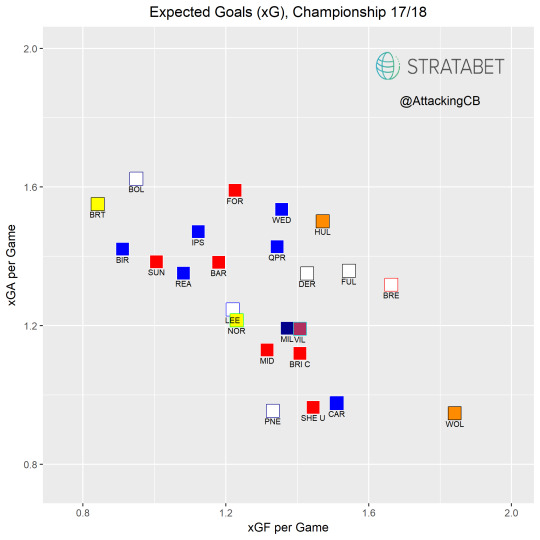
Looking at expected goals, over the course of the season, they appear to be slightly better than their 3 most obvious rivals, but have definitely been struggling. Hull, now level on points with Sunderland, also seem to be better than their position suggests, although they do have a propensity for goals at both ends, which is reflected in the table.
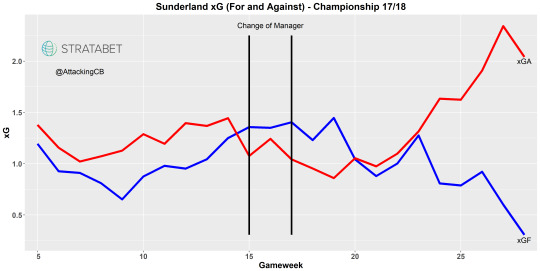
This 5-game rolling average shows an upturn in form towards the end of Grayson’s tenure, continuing through to Coleman’s first few games but in recent weeks, the attacking performance has declined significantly, while the amount of chances conceded has shot up. So what is going on?
Under Coleman, Sunderland have had 3 of their 4 best xGF outputs, against Burton, Birmingham and Fulham, from which they took 7 points. They have also had their 5 lowest outputs, all with incredibly low figures (less than 0.2 xG). They lost 3 of those but managed to hold on for a 0-0 against leaders Wolves with a good defensive performance in one and somehow stole (and I do mean stole) a 1-0 win at Forest, taking just 1 shot in each of those games.
Sunderland have also suffered 4 of their 5 wort defensive performances under Coleman, including thumping defeats away to Sheffield United and Cardiff (who are, admittedly, at the top end of the table). BUT, they have also kept 5 clean sheets, having not managed any before his arrival. They converted 4 of those into wins (two 1-0s and a 2-0) – there has been some inconsistency but they are finding way to grind out results.
It should be noted that 3 of those games with poor numbers featured red cards for Sunderland, which obviously makes things difficult. They have also suffered a long list of injuries, decimating an already insufficient squad. There is another significant issue too – both of their senior strikers have now left the club. Top scorer Lewis Grabban has returned to Bournemouth and James Vaughan has left for Wigan.

Vaughan wasn’t having a great time anyway but Grabban had scored 12 goals (3 from pens), with McGeady and Honeyman the only other players with more than 1 goal. Grabban’s xG far outweighs anyone else in the squad and will be difficult to replace, especially when then isn’t any money to spend. It is no surprise that their attacking play has taken a big hit while he’s been out of the team (he was also previously injured).
Chris Martin, who does have a good record at this level, will seemingly join on loan but for now Sunderland are relying on youngsters Josh Maja and Joel Asoro. Asoro did score at the weekend but the 2 have played a combined total of 600 minutes of Championship football.
My conclusion is that Sunderland are still definitely a struggling side, with some significant squad issues, and have been somewhat fortunate to pick up results in a couple of their recent games. However, that’s the rub of the green that they weren’t getting in the first half of the season and they have found a way to keep clean sheets and win the key games. They have another key game next week at Birmingham, where a win would ease concerns slightly, but they may be in for a long, hard battle for survival. This article was written with the aid of StrataData, which is property of Stratagem Technologies. StrataData powers the StrataBet Sports Trading Platform, in addition to StrataBet Premium Recommendations.
0 notes
Text
Stoke City 0-1 Newcastle United - Tactical Review
Line-Ups
After resting several players for the 5-0 loss against Chelsea, Hughes was more or less able to pick his strongest team, although there was a change from their usual 3-4-3 to 4-3-3. Geoff Cameron was in midfield, alongside Charlie Adam and Joe Allen, with Choupo-Moting and Shaqiri either side of Crouch. Benítez mixed it up, however, leaving both Gayle and Joselu on the bench and selecting Pérez as the only recognised forward. Ritchie, Murphy and Atsu all started and Diamé partnered Shelvey in midfield.
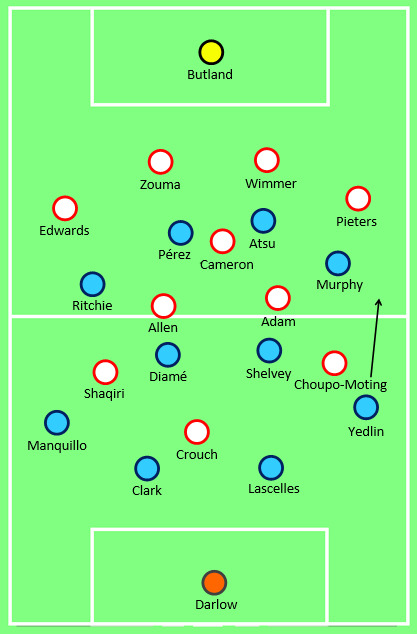
First Half
The most interesting thing about the line-ups was Benítez leaving both of his first-choice strikers on the bench - at least one of them had started every game this season. It looked like Pérez was going to play as the main striker (a role he has rarely played at Newcastle), with Atsu just off him (who normally plays wide).
However, often it was Pérez who dropped deep to link the play, with Atsu looking to use his pace to run in behind. On several occasions, Pérez was able to pick the ball up in space, turn and run at Stoke’s defence, while Atsu, Murphy and sometimes Yedlin made runs beyond him, looking for a throughball.
There was more pace and fluidity about this front 4 than anything we’ve previously seen with Newcastle this season. They were happy to interchange positions, with Pérez and Atsu both happy to drop deep or run the channel, while Murphy and Ritchie often drifted infield.
There was a lack of height without Joselu, who Rafa said was suffering from cramps, but perhaps this was a move to get more runners into the team, particularly as Stoke are lacking in that department. Benítez also indicated that it was something they have been working on: “we know from the training sessions that the partnership between Ayoze and Atsu is good.”
Newcastle were very much on top in the first half and created several chances with similar movements, particularly down the right – with Atsu and Pérez both drifting to that side and Murphy supported by Yedlin. The pace and movement of those 4 caused constant problems and allowed Newcastle to get in down that side time and again, although the final ball or finishing touch was lacking.
The first big chance came when Pérez picked the ball up on halfway, turned and slid Yedlin down the right (Murphy left this space by making a run through the middle), who cut the ball back to Atsu but his first-time shot was saved. Later, Pérez similarly found Murphy down the right and his blocked cross lead to a corner. Pérez nipped in front of Cameron at the front post to flick on and Clark, arriving at the back post, missed from 2 yards. Pérez’s subtle movements were allowing him to find space and impact the game.
Second Half
The start of the second half was more balanced, with neither team creating much. Adam’s delivery from the left was a danger though, particularly with Crouch lurking in the box, and Choupo-Moting showed flashes of quality, forcing a good save from Darlow.
Just after the hour mark, Gayle replaced Atsu and should have won a penalty 5 minutes later when Zouma brought him down in the box. Shelvey sprayed a ball out to Murphy on the right, he cut inside and slid the ball through to Gayle, who had made a good run but was fouled. We have often seen teams get tight to Shelvey to prevent him from influencing the game but he was regularly allowed time and space here to look forwards and spread the play.
On 70 minutes, Stoke made an attacking change, with Berahino coming on for Erik Pieters, switching to 4-4-2, with Cameron moving to centre-back and Wimmer to left-back. However, 3 minutes later, it was Newcastle who got the break-through.
Adam gave the ball away to Murphy just inside Newcastle’s half and he was able to carry the ball almost to the edge of Stoke’s box - he was too quick for Adam and Wimmer didn’t get across quickly enough. He played a great, low cross into the space behind the defence and Pérez ran off the back of Cameron to meet the ball. Having done his best work dropping deep and with Gayle now on the pitch, it was slightly ironic that Pérez made a striker’s run into the box to get the goal but again it was his appreciation of space that was key.
Stoke Pile on the Pressure
Immediately after the goal, Newcastle seemed determined to stay on the front foot and press Stoke but on 81 minutes Dummett replaced Murphy, switching to 5 at the back, and this seemed to signal a change of intent. Diouf had come on for Shaqiri earlier in the half so Stoke now effectively had 4 forwards on the pitch and were going more direct, so the switch made sense – Dummett offered an extra body (to retain the spare man at the back) and extra height to deal with long balls.
However, the problem was that Newcastle dropped too deep and stopped keeping the ball. For the last 10 minutes of the game, Stoke were able to bombard the box and pile on the pressure. They had 4 shots in the first 75 minutes and 7 in the last 15. They also had 3 free-kicks and 4 corners in that period. Newcastle also had opportunities to break on Stoke but they neither killed the game nor held onto the ball and it just kept coming back. Darlow had to make a couple of saves and Newcastle were hanging on a little, given that they had previously looked quite comfortable, but managed to see the game out.
Conclusion
Benítez went with an unconventional front 2, with neither playing as a true striker but taking it in turns to drop deep and Newcastle’s pace and movement caused problems throughout the first half, particularly down the right. Pérez was the chief instigator and confirmed his impact on the game with the only goal, which sees Newcastle jump above Stoke, who drop into the bottom 3.
0 notes
Text
Newcastle United - Statistical Review 17/18, Part 2
After 10 games I wrote that Newcastle, sat on 14 points, looked like being a solid mid-table team. They weren’t scoring many (10) but weren’t conceding many either (9) (not too dissimilar to Burnley, in fact) and looked likely to grind out enough results to keep their head above water.
Well, since then, they’ve picked up just ONE point from 8 games, losing 8 out of the last 9 altogether. They also seem to have forgotten how to defend, conceding 18 in those 8, scoring just 6 and keeping no clean sheets. They have now slipped into the bottom 3 and things are starting to look worrying. So is it as bad as it looks?

Using StrataBet’s chance ratings, which measure the quality of chances created, we can calculate how many goals we would ‘expect’ a team to score or concede. According to these ratings, there is very little between the bottom half teams but Newcastle look like being one of the best. Of course, this is not a perfect measure – Burnley are rated similarly to Brighton yet sit 6th in the table (they may be very lucky, they may be magic, maybe both) – but it doesn’t look too concerning. If we look at shots or shots on target, it is a similar story – they are performing reasonably well.
However, as mentioned, it is the recent form that is worrying.
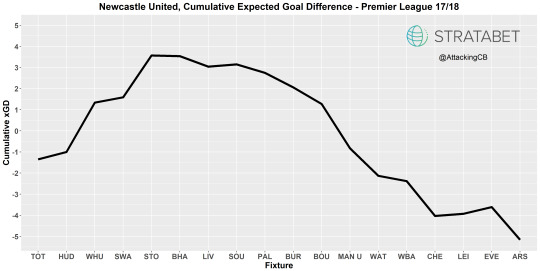
As we can see, after a good start their numbers have tailed off badly and they have barely any positive xG figures since beating Stoke in their 5th game, which is concerning. However, there have been enough tight games in this bad streak that you’d expect to pick up SOME points. They have probably been a little unlucky in recent weeks and individual errors have cost them - certainly they did enough against Leicester and Everton to get something out of the game.
Given these numbers, Newcastle could expect to have closer to 19 points, which would put them comfortably in mid-table. You also wouldn’t expect positive figures for a bottom-half team, by definition, but if this trend were to continue they might be in trouble.
I did point out that Newcastle had a reasonably kind run of fixtures in the first 10 games, which may have contributed slightly to this dip. Now they’ve played everyone once, apart from Man City (who aren’t bad), so any fixture biases should have pretty much evened out.
The ‘magical’ 40 points is seen as the safety mark but you don’t usually need that many - it looks like you will probably be able to stay up with less than a point a game and this has generally been the case in recent years. That being said, another 15 points in the second half of the season would only put Newcastle on 30 points, so an improvement is certainly necessary.
With probably 9 teams that could realistically go down, there is plenty of competition for places and plenty of opportunities to pick up 3 points. However, with Everton having already pulled clear in a short space of time, Crystal Palace and West Ham are also looking much-improved, so this number may reduce.
Many are pinning their hopes on a takeover but it isn’t yet clear if or when that will happen and, in any case, by the end of January there will only be 13 games of the season left – they need to start picking up points before then. It looks like it may be a challenge to stay up with the current squad but, regardless of January transfers, it is far from a hopeless task. Newcastle are still within touching distance of the teams around them and they have shown they are capable with their early-season form. They will be hopeful that their luck will change but they do need to get a bit more out of the players and cut out the costly mistakes.
This article was written with the aid of StrataData, which is property of Stratagem Technologies. StrataData powers the StrataBet Sports Trading Platform, in addition to StrataBet Premium Recommendations.
#nufc#newcastle#united#premier league#epl#analysis#analytics#strata#xg#expected goals#stats#statistics
1 note
·
View note
Text
Newcastle United 2-3 Leicester City – Tactical Review
Line-Ups
Benítez returned to 4-4-2 and a partnership of Gayle and Joselu up front, with Yedlin back in at right-back. Shelvey was again on the bench, as were Atsu and Lascelles, both returning from injury. Leicester were unchanged from their win against Burnley, Puel sticking with 4-2-3-1, with Gray behind Vardy.
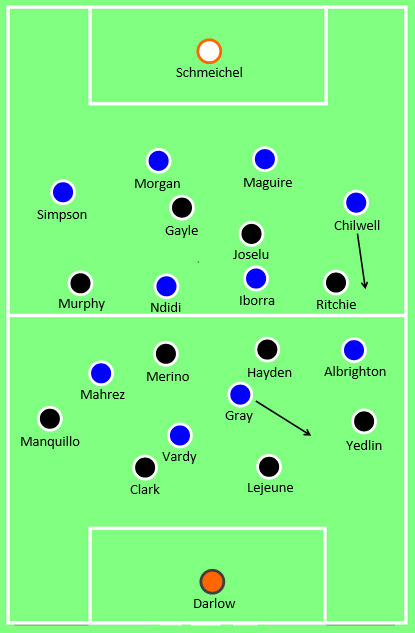
First Half
Newcastle were ahead after just 4 minutes, yet again taking an early lead. Gayle made a run in behind Wes Morgan, in the left channel and Murphy found him with a sublime ball with the outside of his right foot. Gayle pulled it back to Joselu, who was running onto the ball in acres of space and he passed it in.
This opening goal demonstrated the partnership between Gayle and Joselu somewhat - Gayle ran in behind while Joselu had dropped short. Joselu’s lack of pace meant that he couldn’t keep up with Gayle and was in the perfect position for a cut-back.
Leicester equalised through Mahrez after 20 minutes. Merino gave the ball away cheaply in midfield, meaning Mahrez had space to run into through the middle. He skipped past Hayden and shot from about 25 yards - it was a good strike but Darlow should save it.
Most of Leicester’s attacks came down the left, with Gray drifting to that side and Chilwell supporting, creating overloads on that flank. Both Gray and Albrighton looked to cut onto their right and whip balls into the box, both offering good delivery.
On the opposite side, Mahrez was drifting infield too – Leicester’s attacking band of 3, their most creative players, were happy to interchange positions, all looking for space between the lines and their movement caused some problems. Mahrez and Gray in particular looked the most likely players to provide moments of quality.
Leicester were certainly on top in the first half but created little in the way of good chances. They were mostly restricted to long-range shots and crosses. Over the last couple of years, they have generally preferred games where they have less of the ball and space to counter. Puel seems to have them playing more pro-actively, keeping the ball more, but they still looked at their most dangerous when breaking with speed. Out of possession, Mahrez and Gray often stayed in positions where they could break quickly, posing a threat with their pace, although they had few chances to do so.
Newcastle have also tended to look more comfortable in games where the opposition come on to them. They weren’t offering enough of a threat but they weren’t being troubled too much defensively either.
Second Half
The second half started much the same until, just before the hour mark, Mahrez dropped deep, picking the ball up near the halfway line, and played a long diagonal to Albrighton on the opposite side. He excellently cushioned the ball back to Gray, who was given too much space by Hayden (again between the lines in an inside-left position), and his volley was deflected in off Lejeune. The finish was fortuitous but the move was high quality, unsurprisingly featuring all 3 of Leicester’s attacking midfielders.
This prompted Newcastle to become a bit more positive. On came Atsu and Pérez for Murphy and Ritchie and a bit of pressure lead to a corner. The corner wasn’t cleared by Leicester and the ball fell to Gayle, who cut onto his left and equalised, with the help of another deflection.
Newcastle continued to push for a winner. Benítez said after the game that he thought his team looked comfortable at 2-2 and saw an opportunity to win the game and, in truth, Leicester weren’t threatening at that stage – they had no shots on target after their second goal.
Newcastle did have a few dangerous breaks themselves and it was one of these that lead to the winner on 85 minutes. Manquillo broke with the ball down the left, reaching the box before being stopped. The ball broke in the centre circle, with Newcastle not in the best shape and Albrighton was able to find Vardy, making a run into the left channel. Lejeune made a challenge before falling over while Clark, presumably thinking Lejeune needed help, was also drawn towards the ball, leaving a massive gap for Okazaki to run into. Pérez, who had initially let Okazaki run past him, recovered enough to get a toe onto the ball but did the strikers job for him, poking it into the net.
Vardy had had very few opportunities to run in behind the defence during the game but Newcastle couldn’t handle him on the few occasions he did get up to full speed. At this stage of the game, with the score 2-2, Leicester shouldn’t have been able to break so easily, with the 2 centre-backs left so exposed.
Conclusion
Yet again, Newcastle took the lead and weren’t able to get anything out of the game - for all their attacking deficiencies, Newcastle again did enough going forward to win the game. They actually defended reasonably well for the majority of the game but Benítez will again bemoan the mistakes which cost his team. Leicester, however, are a much more established team with some excellent players and demonstrated here how much Newcastle could do with a Gray or Mahrez.
#nufc#lcfc#newcastle#united#leicester city#tactical#analysis#premier league#epl#tactic#mahrez#gray#benitez#puel
0 notes